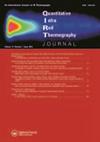Defect shape detection and defect reconstruction in active thermography by means of two-dimensional convolutional neural network as well as spatiotemporal convolutional LSTM network
IF 4.9
3区 工程技术
Q1 INSTRUMENTS & INSTRUMENTATION
引用次数: 14
Abstract
ABSTRACT A neural network (NN) for semantic segmentation (U-Net) was used for the detection of crack-type defects from thermography sequences. For this task, data sequences of forged steel parts were acquired through induction thermography and the corresponding phase images calculated. The results for defect detection were quantitatively evaluated using Intersection over Union (IoU) metric. Further, a combination of 2D convolutional layer as well as LSTM (Long-Short-Term-Memory) is shown, which includes three-dimensional aspects in the form of time dependent and spatial changes and allows a defect shape reconstruction of back wall drillings. Therefore, pulsed thermography sequences were simulated with COMSOL Multiphysics. Finally, the reconstruction results were compared with the ground-truth defect profile using Mean Squared Error (MSE). The approaches provide improvements over conventional methods in non-destructive testing using infrared thermography.二维卷积神经网络和时空卷积LSTM网络在主动热成像中的缺陷形状检测和缺陷重建
摘要将用于语义分割的神经网络(NN)(U-Net)用于从热成像序列中检测裂纹类型的缺陷。为此,通过感应热成像获取锻钢零件的数据序列,并计算相应的相位图像。使用联合交集(IoU)度量对缺陷检测的结果进行定量评估。此外,显示了2D卷积层和LSTM(长短期记忆)的组合,其包括时间相关和空间变化形式的三维方面,并允许后壁钻孔的缺陷形状重建。因此,用COMSOL Multiphysics模拟了脉冲热成像序列。最后,使用均方误差(MSE)将重建结果与真实缺陷轮廓进行比较。在使用红外热成像的无损检测中,这些方法提供了对传统方法的改进。
本文章由计算机程序翻译,如有差异,请以英文原文为准。
求助全文
约1分钟内获得全文
求助全文
来源期刊

Quantitative Infrared Thermography Journal
Physics and Astronomy-Instrumentation
CiteScore
6.80
自引率
12.00%
发文量
17
审稿时长
>12 weeks
期刊介绍:
The Quantitative InfraRed Thermography Journal (QIRT) provides a forum for industry and academia to discuss the latest developments of instrumentation, theoretical and experimental practices, data reduction, and image processing related to infrared thermography.
 求助内容:
求助内容: 应助结果提醒方式:
应助结果提醒方式:


